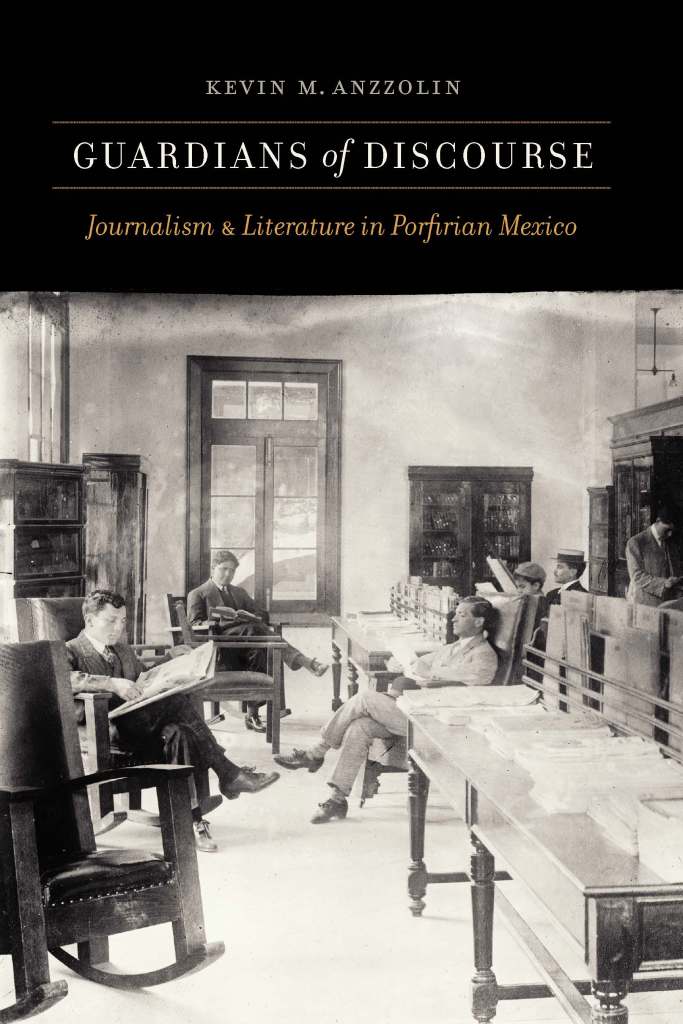Dr. Kevin M. Anzzolin, Lecturer of Spanish, arrived at Christopher Newport University in 2021, where he teaches a wide range of classes. His book, Guardians of Discourse: Literature and Journalism in Porfirian Mexico, will be published this month with the University of Nebraska Press. Therein, he analyzes the representation of journalism in literary texts from Porfirian Mexico. His research focuses primarily on Mexican narrative from the nineteenth to the twenty-first centuries, and his work has been published in journals such as Letras Hispanas, Hispania, and REH. A full list of his publications can be found here.
Every weekday morning during the past five years, Mexican President Manuel López Obrador has, without fail, provided his constituents with news via a daily press conference. Referred to colloquially as la mañanera or “the morning session,” the president’s briefings are a forum to field reporters’ questions, forward the government’s version of events, and dress down political enemies. The president, commonly referred to as AMLO, evinces a largely avuncular tone. Nevertheless, AMLO has also been known to excoriate different media outlets, calling out by name those with whom he disagrees. The president’s daily briefings are but one of his administration’s multipronged efforts to control the press. Having previously announced the shuttering of Mexico’s long-standing news agency Notimex, the organization was officially dissolved by Mexican Congress in December 2023. Last February, AMLO went so far as to dox New York Times journalist Natalie Kitroeff after she wrote a story insinuating the president’s ties with drug cartels. Besieged by cartels and politicians alike, Mexican journalists face some of the most difficult conditions around the world. According to its Freedom Index, the organization Reporters Without Borders ranks Mexico as 128 out of 180 countries.
Yet, it would be difficult to propose that this harsh environment for members of the press is truly novel in the case of Mexico. What, in fact, is new about these conflicts and conundrums? Although it pains me to admit it, the findings of my recently published Guardians of Discourse: Journalism and Literature in Porfirian Mexico suggest that the dire straits in which Mexican journalists find themselves may be little more than a case of the proverbial same old story. How has the public sphere changed in Mexico since the end of the nineteenth century? Have the limits of the freedom of speech been transformed? How has the relationship between journalists, politicians, and bureaucrats changed? What is new in Mexico? What may be surprising is that little is newsworthy.
Under President Porfirio Díaz (1876-1911), Mexico was quickly transformed by newfound social stability, ongoing political liberalization, and significant economic expansion. Yet, intellectuals in Díaz’s Mexico were disquieted by the fact that Mexico consistently lacked a cornerstone feature of modern nation-states: what Jürgen Habermas first conceptualized as a public sphere—an enlightened and objective space where participants bracket socioeconomic status in order to actively participate in rational debate. By exploring unstudied works by writers during this period, my monograph demonstrates that a primary goal of the lettered class was to define the character of public life. Not unlike Mexico’s current president, Díaz, too, was unafraid to exert his political power to craft media coverage and control the press.
Research that I have carried out after writing Guardians bears out the cogency of my manuscript’s original thesis. Most particularly, the Colección Porfirio Díaz, located in the Francisco Xavier Clavigero Library at Mexico City’s Universidad Iberoamericana, contains seemingly endless examples of how concerned Díaz was about the reach of journalists and their depiction of his administration.
For example, in a letter to President Díaz dated November 3, 1891, bureaucrat Ignacio D. Montesinos recounts how he took it upon himself to publicly refute a newspaper’s claims about the president. Tellingly, the letter is sent from San Francisco, California, suggesting Díaz’s concern as to his perception abroad. In another letter dated November 3, 1891, Díaz, writes to one of his foremost generals, Bernardo Reyes, cajoling him to protect journalist Justo Cárdenas, a journalist who ran different newspapers from Laredo, Texas. From 1891 to 97, Cárdenas published El Correo de Laredo and from 1900 to 1919, he published El Demócrata Fronterizo. Ostensibly, Díaz requested protection for Cárdenas given the editor’s routinely sympathetic, even at times laudatory, characterization of Díaz’s administration. In order to promote political and commercial development—and, furthermore, legitimize Díaz’s government among Mexican-Americans, US citizens, and, indeed, the international community—publications such as Cárdenas’ were crucial. This said, a front-page article from El Demócrata Fronterizo and published on November 19, 1904 is revealing. Titled “Educación política, social y Económica de México” [Political, Social, and Economic Education in Mexico] celebrates Díaz as an “extraordinary man” who “planted the tree of peace” in Mexico. Although the relationship between Cárdenas’ journal and Díaz himself was far from slavish, El Demócrata Fronterizo remained faithful to the national project that Díaz’s administration represented. Even as late as 1909, when Díaz was 78-years-old and was serving his seventh term as president, the paper ran a piece on August 14 extolling the virtues of Díaz—the man and the politician. Such were the political fruits of connecting a central government with a network of newspapers, both in Mexico and beyond.
Guardians of Discourse, via archival research, literary production, and twenty illustrations from the period, provides a genealogy of Mexico’s present-day public sphere. The study takes the reader to brothels, into prisons, and throughout the Mexico City demimonde in order to observe the dark business that journalists took part in—both to bolster Díaz’s presidency and critique it. Almost always, they aimed to defend the idea of Mexico, and the freedom of the press. What are the promises and pitfalls of journalism and political life in Mexico as we more fully enter a digital age?

